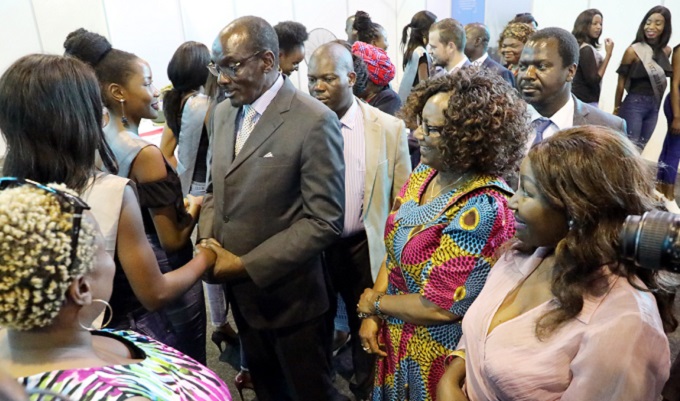Immense burden of water poverty borne by women

Obey Sibanda, Features Reporter
“So long life,” 15-year old Nomzamo Tshalibe from Donda village in Tsholotsho tells herself as she slowly shuffles up a dusty gravel path and follows the cracked plastic sandals in front of her. She has a muddy metal container strapped to her back filled with water which weighs nearly 25 kilograms. One thing for sure, the jerry can is weighing her down. It is like carrying a baby hippo.
At the crack of dawn every morning, Nomzamo who looks twice her age braves the vagaries of weather that have scorched her skin to a leathery blackness ventures out to join other adolescent girls, pregnant women and mothers with small children carrying water containers searching for the rare precious liquid. A single trip is usually about 5 kilometres.
She reaches home carrying her heavy can, not to rest but to do other household chores of cooking, washing, cleaning, and caring for her siblings. A day’s supply of water can amount to multiple trips for poor Nomzamo.
Each time she inspects her bucket at home, she sees a sickening mixture of dirt residue, feathers and water insects.
Her situation is not an isolated one but a graphic indication of this catastrophe in most Matabeleland rural areas and some parts of Bulawayo which have gone for months without running water.
Nomaqhawe Nyathi (30), mother of four from Garanyemba in Gwanda can relate. She already is feeling the effects of frequent, long-distance treks for water. The chore is especially arduous in the long dry season, each trip taking her up to 8 hours.
She packs up two 20-litre-containers on her donkey and carries another herself. She harnesses the container with a strap and wraps it around the top of her head, resting the 25kg container on her back.
Women’s lives in these areas equate to sheer drudgery. The task of providing water for households falls disproportionately to women and girls. To get a bucket of drinking water is a struggle for most women in the country. The virtually dry and dead water resources have lead to acute water scarcity, affecting the socio-economic condition of the society.
Climate change has hit most rural parts hardest, reducing the availability of water, lowering agricultural productivity and leaving thousands hungry.
Changing weather patterns are already causing drought and wet areas are likely to become wetter still, causing devastating floods and loss of life. Last year more than 800 families in Tsholotsho district were displaced from their homes by floods which hit the southern parts of the country.
Women and girls are traditionally responsible for domestic water supply and sanitation, and maintaining a hygienic home environment. As managers at the household level, women also have a higher stake in the improvement of water and sanitation services.
Poor women waste much time walking miles to collect small amounts of water. The water they get is often contaminated; spreading diseases that may kill family members or leave them unable to work.
They get their water from sources that are considered unsafe because they are vulnerable to contamination, such as rivers, streams, ponds and unprotected wells. For women and children especially, every minute of this crisis is real and biting. The lack of water is squeezing the health and lives out of men, women and children.
Preventable, water-borne disease like diarrhoea, typhoid and malaria also keep children out of school. These are the root cause of the crisis and water poverty.
The United Nations Development Programme (UNDP) estimates that nearly half of all people in developing countries at any one time are suffering from an illness caused by bad water or sanitation and a couple of school days are missed each year.
When children or other family members get sick from consuming poor quality water women spend their time providing care.
These responsibilities represent lost opportunities for women’s employment, education, leisure or sleep. When girls begin puberty and start to menstruate, they are disproportionately affected by a lack of safe water and sanitation because they are unable to attend to their hygiene needs at school.
According to Save the Girl Child coordinator Ms Ratidzo Zhou, girls miss class for long periods, skip roughly one quarter of school days, and many drop out altogether.
“When children are unable to attend school and get an education, the workforce of the entire country is affected, and families looking to emerge from widespread poverty find this obstacle very difficult to overcome,” she said.
Unclean water and a lack of basic sanitation are undermining efforts to end extreme poverty and disease in poorest parts of the country.
“The absence of adequate sanitation has a serious impact on health and social development, especially for children”
Matabeleland South Provincial Medical Director, Dr Chipo Chikodzore highlighted that there was a need to revamp ageing water and sanitation infrastructure in the province.
“Waterborne diseases are preventable disease that are used as a barometer of inadequate access to safe clean water and sanitation,” she said
In many cultures, the only time available for women or girls to defecate, if they do not have a toilet, is after dark. Apart from the discomfort caused by the long wait, this can cause serious illness. And there is also a risk of harassment and assault during the nighttime walk to and from the communal defecation fields.
The United Nations estimates that Sub-Saharan Africa alone loses 40 billion hours per year collecting water; the same as an entire year’s labor in all of France. Today, there are around 2.4 billion people who do not use improved sanitation, and 663 million who do not have access to improved water sources.
Improving access to sanitation is a critical step towards reducing the impact of waterborne diseases. It also helps create physical environments that enhance safety, dignity and self-esteem.
When a water solution is put into place, sustainable agriculture is possible. Children get back to school instead of collecting dirty water all day, or being sick from waterborne illnesses. Parents find more time to care for their families, expand minimal farming to sustainable levels, and even run small businesses.










Comments